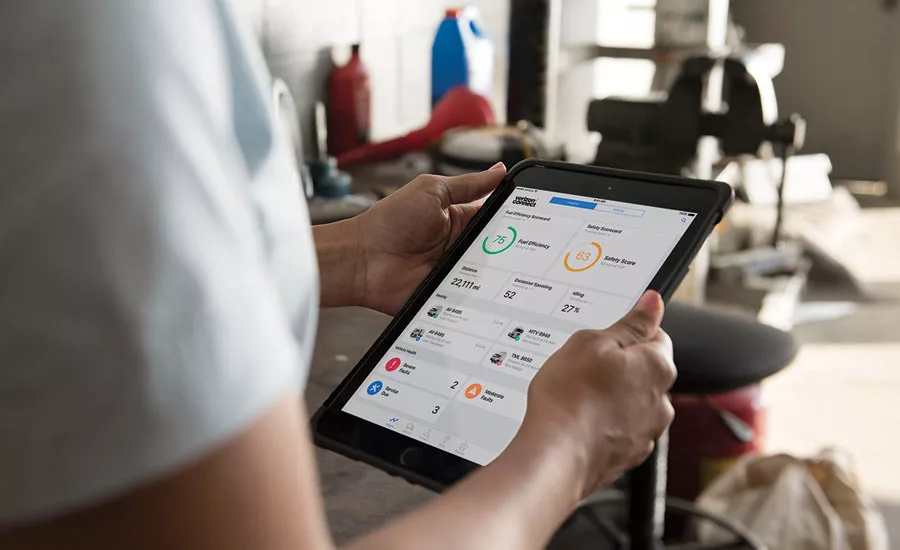Route planning, customer service key to success of telematics
Telematics streamline product tracking, promote driver safety

Telematics provide real-time GPS tracking of vehicles and workers, and actionable insights into fuel use and vehicle maintenance as well as improving driver safety, experts say. (Image courtesy of Verizon Connect)
To get the most out of fleet delivery, telematics have become a must-have technology for beverage distributors and busy warehouses. Not only do these devices provide real-time GPS tracking of vehicles and workers, they provide actionable insights into fuel use, vehicle maintenance and also can track driving behavior and improve safety.
Once an emerging technology, telematics and logistic support has dramatically increased in the past few years to keep pace with SKU proliferation, the need to move products faster, multiple deliveries and even last-minute deliveries that require immediate action, experts note.
“As the last mile delivery landscape has changed, telematics has had to keep pace,” says Tyler Forcum, product manager at Dallas-based Omnitracs. “The GPS capture rate has steadily quickened over the years. Five years ago, getting a location update every five or 10 minutes was common. Now, distributors need to know what’s happening faster, so that immediate action can be taken. As a result, telematics transmits rates have gotten faster.”
To keep pace with faster transmission requirements, Omnitracs’ telematics devices were designed to send data every six seconds, driving precision with on-arrival and departure times and sharpening results in better on-time and missed time window reporting to key accounts, Forcum adds.
Because beverage production and packaging operations rely heavily on automation, telematics data collection for in-house and on-the-road have become indispensable tools, says John Rosenberger, director of iWAREHOUSE Gateway and global telematics for Greene, N.Y.-based The Raymond Corp.
“[T]elematics can inform purchasing decisions, efficiency updates and improve overall operational efficiency, he says. “Without a telematics system, however, that information can be much less robust and may not be used to its fullest advantage. … Telematics within the manufacturing facility and warehouse can determine how effectively the material handling equipment is being used during the movement of the product. From there, delivery operations to retailers can be improved, helping the overall distribution process.
“Telematics can provide important information about a beverage distributor’s lift equipment, … including delivery tasks and equipment run times, operator practices and truck loading/unloading optimization to streamline ‘last mile’ processes and improve fleet and operator performance,” he adds.
Ray Zujus, strategic customer success manager for food and beverage at Atlanta-based Verizon Connect, which combines Telegois and Fleetmatics under a unified name, notes that the explosion of products and SKUs has driven up operational costs, causing operators to become more reliant on connected commercial vehicle software to pinpoint where they can be more efficient and offset costs.
“Our connected commercial vehicle (MRM) solutions include fleet management and telematics, optimized routing and route monitoring (plan versus actual), commercial-grade navigation and a full suite of mobile applications for mobile workers including gamification and compliance apps,” Zujus says.
Telematics and other automation innovations have evolved to assist with batch-picking applications, reducing pick errors and boosting product fulfillment accuracy, The Raymond Corp.’s Rosenberger says. The company’s Pick2Pallet, combined with telematics, can measure and inform decisions about eaches, not just pallets. This makes it easier when smaller amounts of products are being picked, he explains.
Connected vehicles, optimized routing
Verizon Connect’s Zujus highlights that the connection of field teams work extends beyond the vehicle to providing better end service. “Our latest Verizon Connect Workforce offerings enable customers to be able to understand better how far through a visit or job their merchandisers and delivery drivers are, and help to optimize each stop,” he explains. “Improved planning, routing and live ETAs enable our customers to provide better service to their end customers and give their field teams the tools they need to be safer, more efficient and more productive.”
William Salter, chief executive offer at Dallas-based Paragon Software Solutions, notes that trends in the beverage industry develop quickly, e.g., coconut water. More non-glass, portable and eco-friendly packages such as mini bottles, boxes, cans and pouches also are adding to the complexity of distribution.
Telematics also play a pivotal role with the diversification of consumer choices for hotels, bars, restaurants and grocery stores needing to stock a wider range of products, Salter adds. “Most venues have limited storage space, so deliveries consist of smaller volumes, made more frequently. As a result, drink delivery operations are more complex and require more precise route planning,” he says.
Safety first
In addition to keeping tabs on equipment and vehicles, telematics can promote safety through the use of newer technology: video telematics. David Riordan, executive vice president and chief client officer for San Diego-based Lytx, notes that video telematics provide a new level of benefits.
“Our clients use video to identify unsafe and inefficient driving behaviors in their fleet, coach their drivers to improve and reduce risk, and exonerate drivers from false claims,” Riordan says. “One of our clients, Pepsi National Brands, used video telematics to cut their collision rate by 30 percent, largely by developing an extremely effective coaching workflow for their drivers.”
Introduced in September 2017, the cloud-based Lytx Video Services delivers continually recorded video to help clients avoid collisions, as well as monitor, address and optimize safety, compliance and operational efficiency, he explains. It also offers a Lytx DriveCam safety program, which uses predictive analytics to zero in on risky driving behaviors and address them before collisions happen.
Since the Electronic Logging Device (ELD) rule, which was mandated by the Federal Motor Carrier Safety Administration (FMCSA), went into effect in December 2017, operators’ eyes have been opened to the realities of their business, Verizon Connect’s Zujus says. “We have seen numerous instances where companies believe their drivers do not exceed the 100-air-mile radius or hours-per-day rules, when in reality, they do, often times more than they initially thought,” he says.
Lytx’s Riordan points out that ELD systems don’t come trouble-free right out of the gate because no two fleets are the same. For some companies, the ELD mandate is their first foray into digital data.
The days of telematics as a one off, stand-alone solution are gone, Omnitracs’ Forcum says.
“Today, we see more companies operating across the spectrum with facets of their business touching multiple areas,” Forcum says. “As a result, companies need a cross section of solutions.”
Prior to purchasing telematics, he advises that companies consider what type of device they would like to use.
On the horizon, Paragon’s Salter notes that the ability to track the driver will streamline communication and enable the collection of a wider range of data at the point of delivery.
“We also see growing demand for electronic proof of delivery,” he says. “With increased emphasis on environmental concerns, including waste, we see an increasing demand for drinks distributors to handle recycling and re-using bottles and containers — reverse logistics. The efficiencies and levels of control offered by combining telematics with routing and schedule software help make this easier.” BI
Looking for a reprint of this article?
From high-res PDFs to custom plaques, order your copy today!





